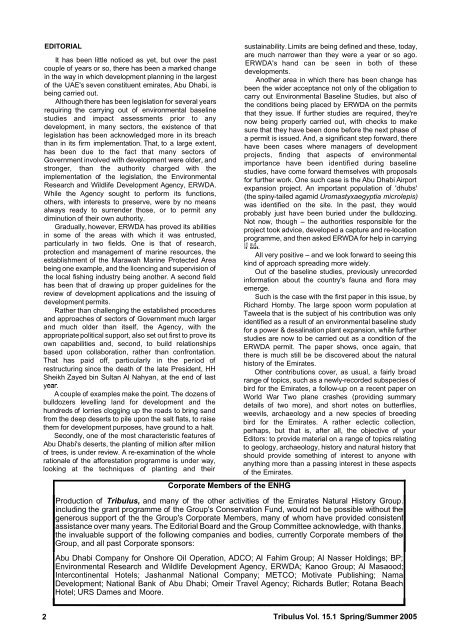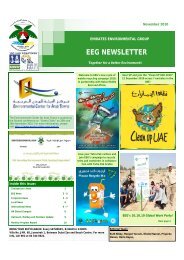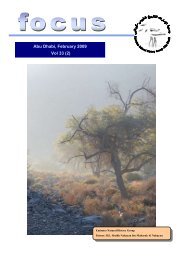Oman (Lepidoptera: Pieridae) - Al Ain Chapter, Emirates Natural ...
Oman (Lepidoptera: Pieridae) - Al Ain Chapter, Emirates Natural ...
Oman (Lepidoptera: Pieridae) - Al Ain Chapter, Emirates Natural ...
Create successful ePaper yourself
Turn your PDF publications into a flip-book with our unique Google optimized e-Paper software.
EDITORIAL sustainability. Limits are being defined and these, today,<br />
It has been little noticed as yet, but over the past<br />
couple of years or so, there has been a marked change<br />
in the way in which development planning in the largest<br />
of the UAE's seven constituent emirates, Abu Dhabi, is<br />
being carried out.<br />
<strong>Al</strong>though there has been legislation for several years<br />
requiring the carrying out of environmental baseline<br />
studies and impact assessments prior to any<br />
development, in many sectors, the existence of that<br />
legislation has been acknowledged more in its breach<br />
than in its firm implementation. That, to a large extent,<br />
has been due to the fact that many sectors of<br />
Government involved with development were older, and<br />
stronger, than the authority charged with the<br />
implementation of the legislation, the Environmental<br />
Research and Wildlife Development Agency, ERWDA.<br />
While the Agency sought to perform its functions,<br />
others, with interests to preserve, were by no means<br />
always ready to surrender those, or to permit any<br />
diminution of their own authority.<br />
Gradually, however, ERWDA has proved its abilities<br />
in some of the areas with which it was entrusted,<br />
particularly in two fields. One is that of research,<br />
protection and management of marine resources, the<br />
establishment of the Marawah Marine Protected Area<br />
being one example, and the licencing and supervision of<br />
the local fishing industry being another. A second field<br />
has been that of drawing up proper guidelines for the<br />
review of development applications and the issuing of<br />
development permits.<br />
Rather than challenging the established procedures<br />
and approaches of sectors of Government much larger<br />
and much older than itself, the Agency, with the<br />
appropriate political support, also set out first to prove its<br />
own capabilities and, second, to build relationships<br />
based upon collaboration, rather than confrontation.<br />
That has paid off, particularly in the period of<br />
restructuring since the death of the late President, HH<br />
Sheikh Zayed bin Sultan <strong>Al</strong> Nahyan, at the end of last<br />
year.<br />
A couple of examples make the point. The dozens of<br />
bulldozers levelling land for development and the<br />
hundreds of lorries clogging up the roads to bring sand<br />
from the deep deserts to pile upon the salt flats, to raise<br />
them for development purposes, have ground to a halt.<br />
Secondly, one of the most characteristic features of<br />
Abu Dhabi's deserts, the planting of million after million<br />
of trees, is under review. A re-examination of the whole<br />
rationale of the afforestation programme is under way,<br />
looking at the techniques of planting and their<br />
are much narrower than they were a year or so ago.<br />
ERWDA's hand can be seen in both of these<br />
developments.<br />
Another area in which there has been change has<br />
been the wider acceptance not only of the obligation to<br />
carry out Environmental Baseline Studies, but also of<br />
the conditions being placed by ERWDA on the permits<br />
that they issue. If further studies are required, they're<br />
now being properly carried out, with checks to make<br />
sure that they have been done before the next phase of<br />
a permit is issued. And, a significant step forward, there<br />
have been cases where managers of development<br />
projects, finding that aspects of environmental<br />
importance have been identified during baseline<br />
studies, have come forward themselves with proposals<br />
for further work. One such case is the Abu Dhabi Airport<br />
expansion project. An important population of 'dhubs'<br />
(the spiny-tailed agamid Uromastyxaegyptia microlepis)<br />
was identified on the site. In the past, they would<br />
probably just have been buried under the bulldozing.<br />
Not now, though - the authorities responsible for the<br />
project took advice, developed a capture and re-location<br />
programme, and then asked ERWDA for help in carrying<br />
it out.<br />
it out.<br />
<strong>Al</strong>l very positive - and we look forward to seeing this<br />
kind of approach spreading more widely.<br />
Out of the baseline studies, previously unrecorded<br />
information about the country's fauna and flora may<br />
emerge.<br />
Such is the case with the first paper in this issue, by<br />
Richard Hornby. The large spoon worm population at<br />
Taweela that is the subject of his contribution was only<br />
identified as a result of an environmental baseline study<br />
for a power & desalination plant expansion, while further<br />
studies are now to be carried out as a condition of the<br />
ERWDA permit. The paper shows, once again, that<br />
there is much still be be discovered about the natural<br />
history of the <strong>Emirates</strong>.<br />
Other contributions cover, as usual, a fairly broad<br />
range of topics, such as a newly-recorded subspecies of<br />
bird for the <strong>Emirates</strong>, a follow-up on a recent paper on<br />
World War Two plane crashes (providing summary<br />
details of two more), and short notes on butterflies,<br />
weevils, archaeology and a new species of breeding<br />
bird for the <strong>Emirates</strong>. A rather eclectic collection,<br />
perhaps, but that is, after all, the objective of your<br />
Editors: to provide material on a range of topics relating<br />
to geology, archaeology, history and natural history that<br />
should provide something of interest to anyone with<br />
anything more than a passing interest in these aspects<br />
of the <strong>Emirates</strong>.<br />
I Corporate Members of the ENHG I<br />
Production of Tribulus, and many of the other activities of the <strong>Emirates</strong> <strong>Natural</strong> History Group<br />
including the grant programme of the Group's Conservation Fund, would not be possible without the<br />
generous support of the the Group's Corporate Members, many of whom have provided consistenl<br />
assistance over many years. The Editorial Board and the Group Committee acknowledge, with thanks<br />
the invaluable support of the following companies and bodies, currently Corporate members of the<br />
Group, and all past Corporate sponsors:<br />
Abu Dhabi Company for Onshore Oil Operation, ADCO; <strong>Al</strong> Fahim Group; <strong>Al</strong> Nasser Holdings; BP;<br />
Environmental Research and Wildlife Development Agency, ERWDA; Kanoo Group; <strong>Al</strong> Masaood;<br />
Intercontinental Hotels; Jashanmal National Company; METCO; Motivate Publishing; Nama<br />
Development; National Bank of Abu Dhabi; Omeir Travel Agency; Richards Butler; Rotana Beach<br />
Hotel; URS Dames and Moore.<br />
2 Tribulus Vol. 15.1 Spring/Summer 2005




